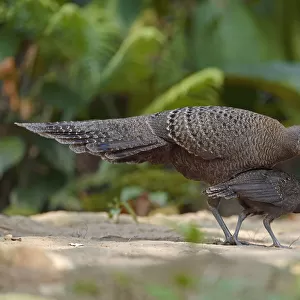Pictograph detail of a Lion attack, Libya
![]()

Wall Art and Photo Gifts from Science Photo Library
Pictograph detail of a Lion attack, Libya
Pictograph detail of a Lion attack, Acacus, south west Libya, believed to have been painted around 9, 000 years ago. A dead auroch (a now extinct species) is depicted on its back centre left, above which is the lion. A herdsman waves 2 sticks to protect another auroch from attack. Painted with ochre this image displays remarkable artistic skill and stylistic invention. Pictographs of the husbandry of cattle are common throughout the Sahara and indicate a savannah environment during what was probably its last wet phase. Most of the human figures in these cave paintings lack any facial features, the emphasis instead being placed on the shaping of the figures. Ochre was the main pigment used by early humans in rock art and body painting; and sites showing evidence of prehistoric ochre mining have been discovered in the Sahara
Science Photo Library features Science and Medical images including photos and illustrations
Media ID 6317297
© DAVID PARKER/SCIENCE PHOTO LIBRARY
Attack Auroch Cattle Cave Painting Extinct Humans Hunt Libya Lion Mining Ochre Painting Pictograph Pigment Pre Historic Rock Art Sahara Savannah Species Acacus Body Painting Herdsman
EDITORS COMMENTS
This print showcases a detailed pictograph of a lion attack in Acacus, southwest Libya, believed to have been painted approximately 9,000 years ago. The artwork exhibits remarkable artistic skill and stylistic innovation as it depicts a deceased auroch, an extinct species, lying on its back at the center left. Above this fallen creature stands the mighty lion, poised for its predatory assault. In an act of bravery and protection, a herdsman can be seen vigorously waving two sticks to defend another auroch from the imminent attack. The image is adorned with ochre pigment which was commonly used by early humans for rock art and body painting purposes. This particular pictograph not only highlights the talent of our ancient ancestors but also provides valuable insights into their way of life during what is believed to be the last wet phase of the Sahara environment. Interestingly, most human figures depicted in these cave paintings lack facial features; instead, emphasis is placed on meticulously shaping their forms. Furthermore, evidence suggests that prehistoric ochre mining sites have been discovered in the Sahara region. Pictographs depicting cattle husbandry are prevalent throughout this vast desert landscape and indicate an existence within savannah-like surroundings. This extraordinary photograph offers us glimpses into our distant past while reminding us of humanity's enduring fascination with capturing moments through artistry and storytelling.
MADE IN THE USA
Safe Shipping with 30 Day Money Back Guarantee
FREE PERSONALISATION*
We are proud to offer a range of customisation features including Personalised Captions, Color Filters and Picture Zoom Tools
SECURE PAYMENTS
We happily accept a wide range of payment options so you can pay for the things you need in the way that is most convenient for you
* Options may vary by product and licensing agreement. Zoomed Pictures can be adjusted in the Cart.



